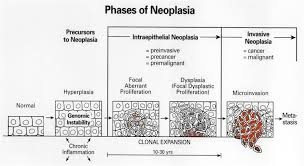neoplastic
英 [ˌniː.əʊˈplæs.tɪk]
美 [ˌniː.əˈplæs.tɪk]
- adj. [肿瘤] 瘤的;新造型主义的

记忆方法
为了记忆“neoplastic”,可以采用以下记忆方法:
1. 分解单词:将“neoplastic”分解为“neo”和“plastic”。
2. 联想意义:“neo”通常与“new”(新的)相关联。
3. 结合词根:“plastic”源自希腊语,意为“形成”或“塑造”。
4. 形成联想:想象一个“new”形成(neo-plastic)的“shape”(形状),这在医学上通常指新生的肿瘤或异常组织。
通过这样的联想,可以将“neoplastic”记忆为“新形成的形状”,这在医学领域指新生的肿瘤组织。
1. 分解单词:将“neoplastic”分解为“neo”和“plastic”。
2. 联想意义:“neo”通常与“new”(新的)相关联。
3. 结合词根:“plastic”源自希腊语,意为“形成”或“塑造”。
4. 形成联想:想象一个“new”形成(neo-plastic)的“shape”(形状),这在医学上通常指新生的肿瘤或异常组织。
通过这样的联想,可以将“neoplastic”记忆为“新形成的形状”,这在医学领域指新生的肿瘤组织。
以上内容由AI生成, 仅供参考和借鉴
权威例句
- 1. A patient with advanced neoplastic disease often presents with anemia.
- 晚期肿瘤病人常有贫血.
- 2. Normal and neoplastic tissues can usually be transplanted.
- 正常和肿瘤组织一般都能移植.
- 3. Examination of the sputum for neoplastic cells may establish the diagnosis in some cases.
- 检查痰中瘤细胞,可对某些病例作出诊断.
- 4. To master concept , differences between neoplastic and nonneoplastic hyperplasia.
- 掌握肿瘤的概念、肿瘤性增生和非肿瘤性增生的区别.
- 5. Many of the neoplastic cells have clear vacuoles of mucin.
- 很多肿瘤细胞有明显的黏液空泡.